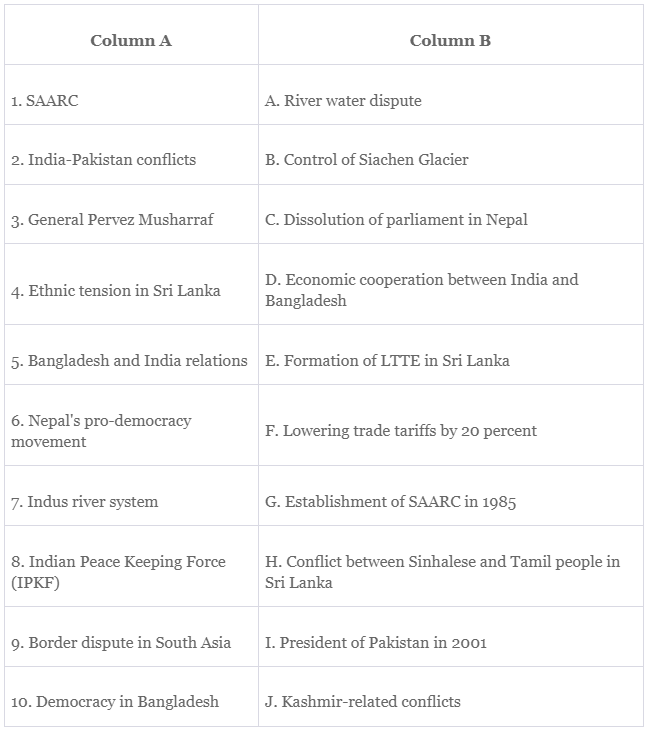Worksheet: Contemporary South Asia | Political Science Class 12 - Humanities/Arts PDF Download
| Table of contents |

|
| Fill in the Blanks |

|
| Match the Column |

|
| Assertion and Reason Based |

|
| Very Short Answer Type Questions |

|
| Short Answer Type Questions |

|
| Long Answer Type Questions |

|
Fill in the Blanks
Q1: South Asia is bounded by the _________ in the north.
Q2: _________ and _________ have successfully maintained democracy since independence.
Q3: Bangladesh was part of _________ until 1971.
Q4: The militant organization demanding a separate country in Sri Lanka was called _________.
Q5: SAARC stands for _________.
Q6: SAFTA aims at lowering trade tariffs by _________ percent by 2007.
Q7: The first era of military government in Pakistan was under General _________.
Q8: The Indian Ocean lies to the _________ of South Asia.
Q9: Nepal became a constitutional monarchy in _________.
Q10: The ethnic conflict in Sri Lanka was between the _________ and _________ people.
Match the Column
Q1: 
Assertion and Reason Based
Q1: Assertion: India and Sri Lanka have stable democracies.
Reason: Both countries have successfully resolved their ethnic tensions.
(a) Both Assertion and Reason are true, and Reason is the correct explanation for Assertion.
(b) Both Assertion and Reason are true, but Reason is not the correct explanation for Assertion.
(c) Assertion is true, but Reason is false.
(c) Both Assertion and Reason are false.
Q2: Assertion: SAFTA was signed in 2004 by South Asian countries.
Reason: SAFTA aims to promote cultural exchange among member nations.
(a) Both Assertion and Reason are true, and Reason is the correct explanation for Assertion.
(b) Both Assertion and Reason are true, but Reason is not the correct explanation for Assertion.
(c) Assertion is true, but Reason is false.
(c) Both Assertion and Reason are false.
Q3: Assertion: Nepal's king dismissed the government in 2002.
Reason: There was a conflict between democratic, maoist, and monarchist forces.
(a) Both Assertion and Reason are true, and Reason is the correct explanation for Assertion.
(b) Both Assertion and Reason are true, but Reason is not the correct explanation for Assertion.
(c) Assertion is true, but Reason is false.
(c) Both Assertion and Reason are false.
Q4: Assertion: Bangladesh was part of Pakistan until 1971.
Reason: The West Pakistani leadership-dominated government refused to call an assembly after the Awani League's victory in the 1970 election.
(a) Both Assertion and Reason are true, and Reason is the correct explanation for Assertion.
(b) Both Assertion and Reason are true, but Reason is not the correct explanation for Assertion.
(c) Assertion is true, but Reason is false.
(c) Both Assertion and Reason are false.
Very Short Answer Type Questions
Q1: What is the purpose of SAARC?
Q2: Name the organization demanding a separate country in Sri Lanka.
Q3: Who was the leader of the Awani League in Bangladesh?
Q4: Which countries are in conflict over the Siachen Glacier?
Q5: Name the river system over which India and Pakistan have disputes.
Q6: When did Nepal become a constitutional monarchy?
Q7: Who removed Prime Minister Nawaz Sharif in Pakistan?
Q8: Which external forces affect South Asian politics?
Q9: What was the political status of Maldives before 1968?
Q10: Which Indian state shares a border with Bangladesh?
Short Answer Type Questions
Q1: Discuss the political changes in Pakistan from 1971 to the present day.
Q2: Explain the ethnic conflict in Sri Lanka and its impact on the country's democracy and economy.
Q3: Describe the formation and objectives of SAARC.
Q4: Analyze the conflicts between India and Pakistan over the years.
Q5: Discuss the political developments in Nepal leading to its status as a constitutional monarchy.
Q6: Explain the impact of the Awani League's victory on the political landscape of Bangladesh.
Q7: Describe the special relationship between Bhutan and India.
Q8: Explain the impact of external forces like the United States and China on South Asian politics.
Long Answer Type Questions
Q1: Discuss the evolution of democracy in Bangladesh, highlighting key events and challenges faced by the nation.
Q2: Analyze the impact of ethnic conflict on Sri Lanka's democracy, economy, and international relations.
Q3: Evaluate the role of SAARC in promoting regional cooperation and economic integration among South Asian nations.
Q4: Examine the complex relationship between India and Pakistan, analyzing the historical context, conflicts, and attempts at reconciliation.
You can access the solutions to this worksheet here.
|
34 videos|308 docs|51 tests
|
FAQs on Worksheet: Contemporary South Asia - Political Science Class 12 - Humanities/Arts
| 1. What are the key themes explored in the contemporary South Asia curriculum? |  |
| 2. How does the assertion and reason format work in exams on contemporary South Asia? |  |
| 3. What types of questions can be expected in a long answer section about contemporary South Asia? |  |
| 4. How can students prepare for very short answer type questions in the context of contemporary South Asia? |  |
| 5. What is the importance of matching columns in contemporary South Asia assessments? |  |




















